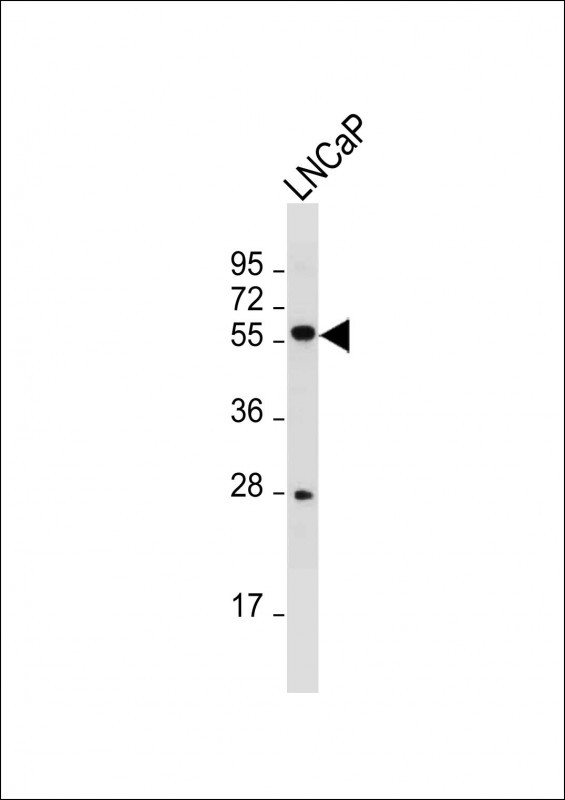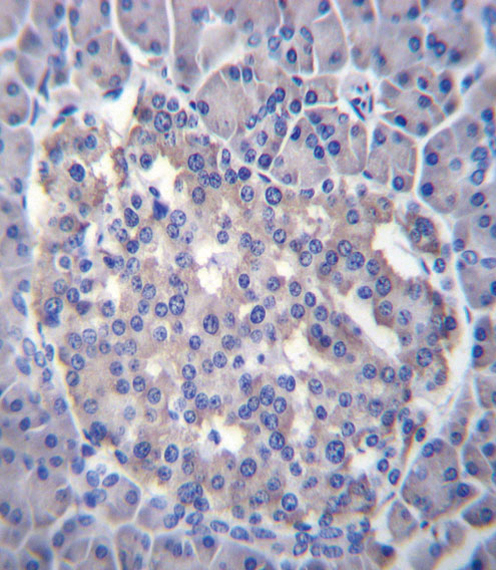Sestrin-3 Antibody (Center Y335)
Affinity Purified Rabbit Polyclonal Antibody (Pab)
- SPECIFICATION
- CITATIONS: 5
- PROTOCOLS
- BACKGROUND

Application
| IHC-P, WB, E |
|---|---|
| Primary Accession | P58005 |
| Other Accession | Q9CYP7, NP_653266.2 |
| Reactivity | Human |
| Predicted | Mouse |
| Host | Rabbit |
| Clonality | Polyclonal |
| Isotype | Rabbit IgG |
| Calculated MW | 57291 Da |
| Antigen Region | 320-347 aa |
| Gene ID | 143686 |
|---|---|
| Other Names | Sestrin-3, SESN3, SEST3 |
| Target/Specificity | This Sestrin-3 antibody is generated from rabbits immunized with a KLH conjugated synthetic peptide between 320-347 amino acids from the Central region of human Sestrin-3. |
| Dilution | IHC-P~~1:10~50 WB~~1:2000 E~~Use at an assay dependent concentration. |
| Format | Purified polyclonal antibody supplied in PBS with 0.09% (W/V) sodium azide. This antibody is purified through a protein A column, followed by peptide affinity purification. |
| Storage | Maintain refrigerated at 2-8°C for up to 2 weeks. For long term storage store at -20°C in small aliquots to prevent freeze-thaw cycles. |
| Precautions | Sestrin-3 Antibody (Center Y335) is for research use only and not for use in diagnostic or therapeutic procedures. |
| Name | SESN3 (HGNC:23060) |
|---|---|
| Function | May function as an intracellular leucine sensor that negatively regulates the TORC1 signaling pathway (PubMed:25263562). May also regulate the insulin-receptor signaling pathway through activation of TORC2 (By similarity). This metabolic regulator may also play a role in protection against oxidative and genotoxic stresses (By similarity). May prevent the accumulation of reactive oxygen species (ROS) through the alkylhydroperoxide reductase activity born by the N-terminal domain of the protein (By similarity). |
| Cellular Location | Cytoplasm. |
| Tissue Location | Widely expressed.. |

Provided below are standard protocols that you may find useful for product applications.
Background
Sestrins form a small family of redox enzymes which regulate accumulation of Reactive Oxygen Species. They protect cells and their DNA against oxidative damage and regulate cell growth and viability. These genes are often deregulated in cancers and their inactivation accelerates the growth of model tumors in mice.
References
Rose, J.E., et al. Mol. Med. 16 (7-8), 247-253 (2010) :
Chen, C.C., et al. Dev. Cell 18(4):592-604(2010)
Peeters, H., et al. Hum. Genet. 112 (5-6), 573-580 (2003) :
If you have used an Abcepta product and would like to share how it has performed, please click on the "Submit Review" button and provide the requested information. Our staff will examine and post your review and contact you if needed.
If you have any additional inquiries please email technical services at tech@abcepta.com.














 Foundational characteristics of cancer include proliferation, angiogenesis, migration, evasion of apoptosis, and cellular immortality. Find key markers for these cellular processes and antibodies to detect them.
Foundational characteristics of cancer include proliferation, angiogenesis, migration, evasion of apoptosis, and cellular immortality. Find key markers for these cellular processes and antibodies to detect them. The SUMOplot™ Analysis Program predicts and scores sumoylation sites in your protein. SUMOylation is a post-translational modification involved in various cellular processes, such as nuclear-cytosolic transport, transcriptional regulation, apoptosis, protein stability, response to stress, and progression through the cell cycle.
The SUMOplot™ Analysis Program predicts and scores sumoylation sites in your protein. SUMOylation is a post-translational modification involved in various cellular processes, such as nuclear-cytosolic transport, transcriptional regulation, apoptosis, protein stability, response to stress, and progression through the cell cycle. The Autophagy Receptor Motif Plotter predicts and scores autophagy receptor binding sites in your protein. Identifying proteins connected to this pathway is critical to understanding the role of autophagy in physiological as well as pathological processes such as development, differentiation, neurodegenerative diseases, stress, infection, and cancer.
The Autophagy Receptor Motif Plotter predicts and scores autophagy receptor binding sites in your protein. Identifying proteins connected to this pathway is critical to understanding the role of autophagy in physiological as well as pathological processes such as development, differentiation, neurodegenerative diseases, stress, infection, and cancer.



